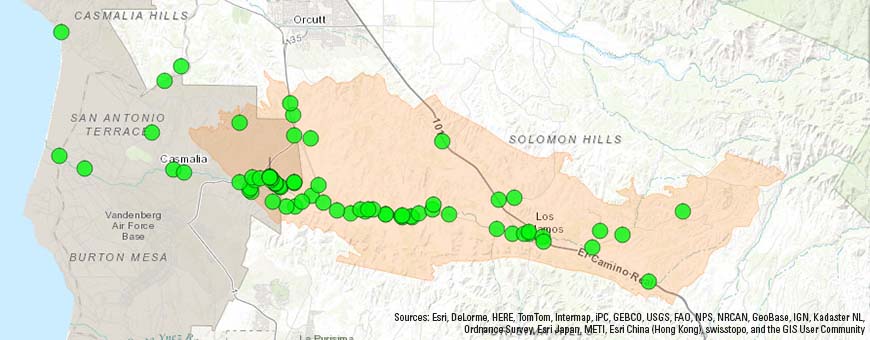San Antonio Creek Water Availability
Water-Chemistry Monitoring
Historical water-chemistry data will be used in conjunction with data collected as part of this study. Water chemistry samples will be collected from monitoring wells installed as part of this study, including two multiple-well monitoring sites (monitoring different depths in the aquifer) and eight shallow monitoring wells. Samples will also be collected from about 15 existing wells (locations to be determined). These samples will be analyzed for chemical and isotopic constituents to help evaluate the regional source(s), flowpath(s), and age(s) of water from wells. This information will be used to help characterize the groundwater-flow system and document differences in water chemistry, both areally and vertically within the basin.

Well sites in the San Antonio Creek Valley where groundwater chemistry samples have been and/or are being taken by the USGS. Map image is the intellectual property of Esri and is used herein under license.
Proposed Water-Chemistry Sampling

Water chemistry samples will be collected, transmitted, analyzed, and archived in accordance with procedures outlined in the USGS National Field Manual for the Collection of Water-Quality Data.
Water-chemistry data were collected from newly installed monitoring wells, including two multiple-well monitoring sites and eight shallow monitoring wells installed in 2015 and 2016. Samples were also collected from about 15 existing production and monitoring wells. Because surface-water infiltration is a major source of groundwater recharge, surface-water samples were collected from streamflow-gaging stations and analyzed for similar constituents as the groundwater samples. Newly collected data will be augmented with historical water chemistry data available throughout the study area.
Detailed Listing of Chemical Analyses
- Dissolved oxygen
- Specific conductance
- pH
- Water temperature
- Alkalinity
- Deuterium (Hydrogen-2), also called heavy hydrogen
- Oxygen-18
- Strontium isotopes
- Tritium (Hydrogen-3), radioactive isotope: half-life of 12.32 years
- Carbon-13, stable isotope
- Carbon-14, radioactive isotope: half-life of 5,730 ± 40 years
- Nitrogen
- Argon
- Methane
- Aluminum
- Antimony
- Arsenic
- Barium
- Boron
- Bromide
- Cadmium
- Calcuim
- Chloride
- Chromium (total)
- Fluoride
- Iodide
- Iron
- Lead
- Lithium
- Magnesium
- Manganese
- Molybdenum
- Potassium
- Silica
- Sodium
- Strontium
- Sulfate
- Total dissolved solids
- Uranium
- Vanadium
- Ammonia
- Nitrate
- Nitrite
- Orthophosphate
- Phosphorous
Laboratories Performing Analyses:
- USGS National Water Quality Laboratory (NWQL) in Denver, CO
- USGS Reston Stable Isotope Laboratory (RSIL) in Reston, VA
- USGS Menlo Park Trace Metal Laboratory (MITL) in Menlo Park, CA
- USGS Menlo Park Tritium Laboratory in Menlo Park, CA
- USGS Groundwater Dating Laboratory in Reston, VA, conducts dissolved gas N2/Ar analysis
- Laboratories under contract with the U.S. Geological Survey will analyze samples for carbon isotopes
Cooperating Agencies
Santa Barbara County Water Agency
Related USGS Publications
Appraisal of Ground-Water Resources in the San Antonio Creek Valley
Geology and Ground Water of San Antonio Creek Valley, Santa Barbara County, California
Groundwater Quality in the South Coast Range Coastal Groundwater Basins, California
Other Related Publications
San Antonio Creek Coordinated Resource Management Plan
Ground Water Quality and Hydrology Data, San Antonio Creek Basin
Potential Effects of Increased Ground-Water Pumpage on Barka Slough, San Antonio Creek Valley


